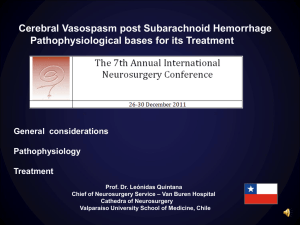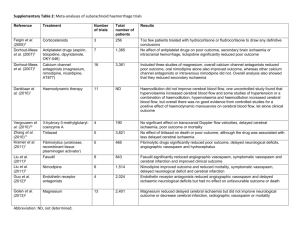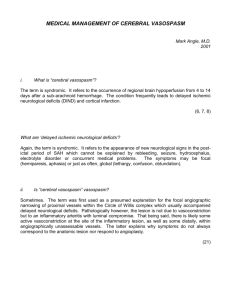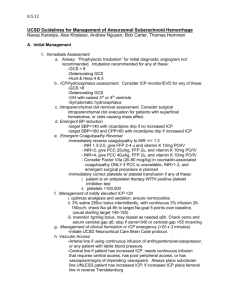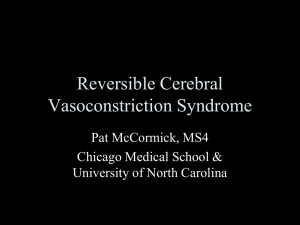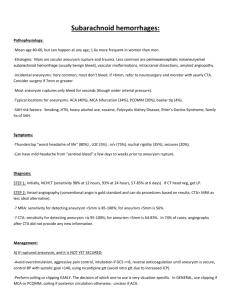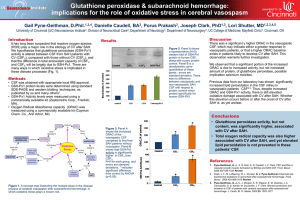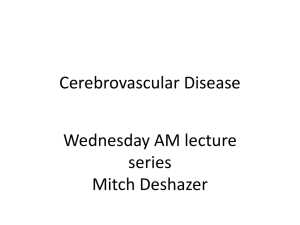Cerebral Vasospasm following Subarachnoid
advertisement
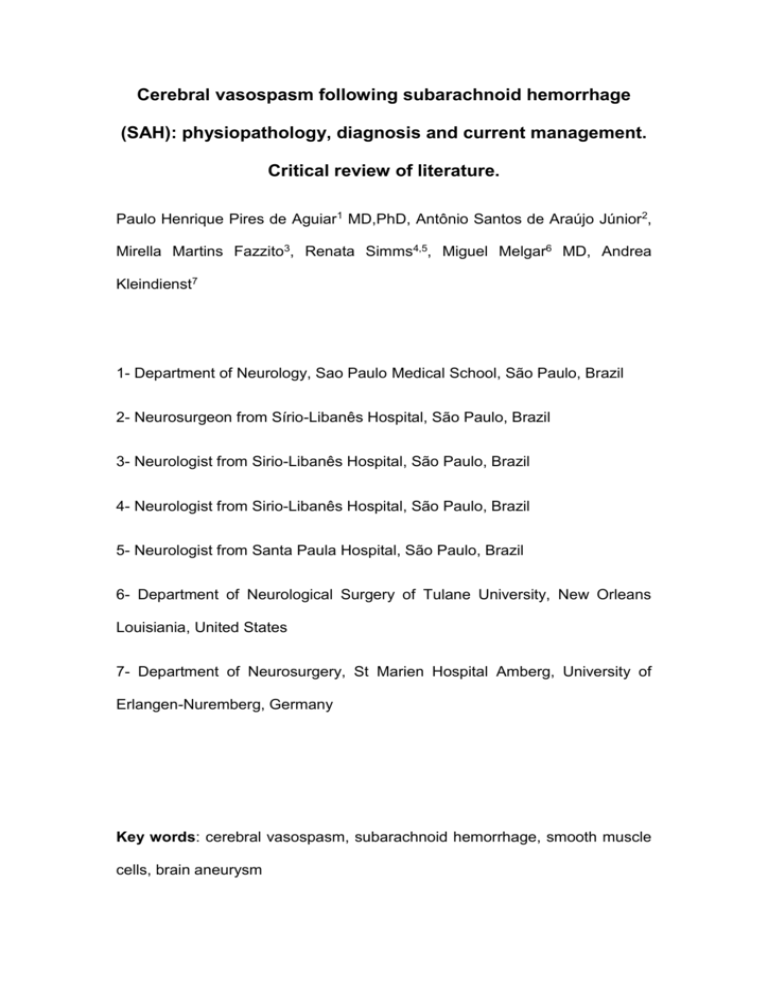
Cerebral vasospasm following subarachnoid hemorrhage (SAH): physiopathology, diagnosis and current management. Critical review of literature. Paulo Henrique Pires de Aguiar1 MD,PhD, Antônio Santos de Araújo Júnior2, Mirella Martins Fazzito3, Renata Simms4,5, Miguel Melgar6 MD, Andrea Kleindienst7 1- Department of Neurology, Sao Paulo Medical School, São Paulo, Brazil 2- Neurosurgeon from Sírio-Libanês Hospital, São Paulo, Brazil 3- Neurologist from Sirio-Libanês Hospital, São Paulo, Brazil 4- Neurologist from Sirio-Libanês Hospital, São Paulo, Brazil 5- Neurologist from Santa Paula Hospital, São Paulo, Brazil 6- Department of Neurological Surgery of Tulane University, New Orleans Louisiania, United States 7- Department of Neurosurgery, St Marien Hospital Amberg, University of Erlangen-Nuremberg, Germany Key words: cerebral vasospasm, subarachnoid hemorrhage, smooth muscle cells, brain aneurysm ABSTRACT The cerebral vasospasm and the delayed cerebral ischemia remain a source of substantial morbidity and mortality following aneurysmal subarachnoid hemorrhage (SAH). Hemodynamic manipulation better known as ‘triple H’ therapy is routinely used in the management of patients with acute vasospasm following subarachnoid hemorrhage. The rationale of inducing hypertension, hypervolemia and hemodilution is to improve blood flow to the injured brain and prevent secondary ischemia. While the Ca2+ antagonist Nimodipine is still the only drug with proven benefit on neurologic outcome following SAH, several alternatives are under research. Tirilazad is not effective, and studies of hemodynamic maneuvers, magnesium, statin medications, endothelin antagonists, steroid drugs, anticoagulant/antiplatelet agents, and intrathecal fibrinolytic drugs have yielded inconclusive and controversial results Steroids drugs and anticoagulant/antiplatelet agents have been abandoned so far because of the lack of efficacy. The purpose of the present paper is to provide a systematic review of the existing literature on the treatment of cerebral vasospasm. 2 RESUMO O vasoespasmo cerebral e a isquemia cerebral tardia respondem de maneira substancial para a morbidade e mortalidade da hemorragia subaracnóide (HSA) de etiologia aneurismática. A terapia hemodinâmica, mais conhecida como “três-H”, é usada rotineiramente no manejo dos pacientes com vasoespasmo secundário à HSA. A razão de se induzir hipertensão relativa, hipervolemia e hemodiluição nestes doentes é melhorar o fluxo sanguíneo cerebral e evitar a isquemia tardia. Atualmente, apenas o bloqueador de canal de Calcio Nimodipina tem benefício comprovado no tratamento do vasoespasmo na HSA. Várias outras alternativas estão sendo estudadas. O Tirilazad não é efetivo, e vários outros têm resultados contoversos, tais como: sufato de magnésio, estatinas, antagonistas de endotelina, esteróides, antiagregantes plaquetários, e fibrinolíticos intratecais. O objetivo deste trabalho é promover uma revisão sistemática da literatura existente acerca do tratamento do vasoespasmo cerebral. Palavras-chave: vasoespasmo cerebral, hemorragia subaracnóide, aneurisma cerebral 3 INTRODUCTION Aneurysmal subarachnoid hemorrhage (SAH) is related with a mortality of about 50%. In addition to the hazards of a second hemorrhage, vasospasm contributes substantially to secondary brain damage and post-operative stroke. Vasospasm refers to a contraction of smooth muscle cells in the wall of cerebral arteries. However, the pathophysiology is not well understood. This article reviews the existing literature on this important topic in vascular neurosurgery and highlights some of the most recent findings and treatment options. DEFINITION The term "cerebral vasospasm" is commonly used to refer to the combination of a delayed onset of ischemic neurological deficits following aneurysmal SAH ("symptomatic vasospasm") and the narrowing of cerebral vessels documented by angiography or other vessels documented by angiography or other studies ("angiographic or arterial vasospasm") (Figure 1). Arterial vasospasm typically appears 3 to 4 days after rupture and reaches a peak incidence and severity at 7 to 10 days 1. Figure 1: Angiographic vasospasm in aneurysm of middle cerebral artery (lateral angiographic view). 4 EPIDEMIOLOGY The incidence and time course of symptomatic vasospasm parallels that of arterial vasospasm. However, while in 40% to 70% of patients arterial narrowing is evident – as documented by angiography or transcranial doppler sonography, only 20% to 30% develop the clinical symptoms. The most important factors determining the clinical effect of arterial vasospasm are the severity and extent of vessel narrowing. Symptomatic vasospasm typically begins 4 to 5 days after SAH, and is characterized by the insidious onset of confusion and a decreasing level of consciousness. When the arterial narrowing is pronounced, these symptoms may progress to focal neurological deficits, infarction, coma and death. In less severe cases, neurological recovery can be expected as soon as the arterial narrowing resolves 1. Cerebral vasospasm will develop in more than half of SAH patients, and symptomatic vasospasm will occur in approximately one-third, which is associated with neurologic symptoms of ischemia 2. According to a demographic study at the University of Mississippi, 1993 to 1999, patients with symptomatic vasospasm have a high prevalence of preexisting chronic morbidity. 75% of patients have a known medical history of either hypertension or diabetes, or both. While the mortality in African American and Caucasian male did not differ significantly, it was statistically higher than in the combined female groups 3. A systemic review of untreated unruptured cerebral aneurysms (UCA) in Japan showed that the risk of rupture is significantly higher than that reported by a large-scale North American and European cohort studies 4. This difference in the rupture risk may result from differences in the racial or 5 genetic background, although a study bias may be evident. Morita et al conclude that untreated UCAs in Japan may have a significantly higher rate of rupture 4. These findings can partially explain an excessive number of SAH and vasospasm in Japan. Female gender is a significant risk factor determining the onset of vasospasm following SAH, and may be as high as 1:9 according to the casuistic study of Quinn et al 5. However it has to be considered that there exists a female predominance among patients with aneurysmal SAH 6,7. The approximated male to female ratio has been reported as 1:2 8, with a similar mortality ratio 9. Hormonal changes due to menopause have been proposed as an explanation for gender differences 10,11. Recent research has advocated that hormone replacement therapy may have a protective role against SAH. The decline of estrogen levels during and after menopause may result in a decreased collagen content within arterial vessel walls, and hence predispose to aneurysm formation 12. Based on a recent study in West Yorkshire, with 100 cases of aneurysmal SAH cases per year among a population of 2.5 million, the mean age of patients with SAH was 51 years, both in male and female, while within the vasospasm group, the mean age was 49 years 5. With respect to the total vasospasm group, half progress to cerebral infarction and half recover without deficit. However, it is important to recognize that angiographic findings may not correlate with the patient's clinical presentation 13. Several factors are associated with the risk of ischemia: large volume of initial SAH, dehydration, use of antifibrinolytic agents, arterial hypotension, increased intracranial pressure, and reduced oxygen delivery 2. 6 Furthermore, in the past decades studies demonstrated risk factors for the development of vasospasm: thickness of blood clot on the initial cranial computed tomography (CT), early increase in transcranial Doppler flow velocities, Glasgow coma score < 15, presence of a carotid or anterior cerebral artery aneurysm, age < 50 years, good neurological grade (World Federation of Neurological Surgeons (WFNS) grade 1 and 2) and hyperglycemia 14,15,16. Applying the WFNS grading scale in a study of 1635 SAH patients in Europe, Australia, New Zealand, South Africa and North America 1991 to 1997, an unfavorable outcome due to vasospasm occurred in 13% WFNS 1, 20% WFNS 2, 42 % WFNS 3, 51% WFNS 4 and 68% WFNS 5 17. An unfortunate case is shown to emphasize the poor outcome that vasospasm secondary to subarachnoid hemorrhage may develop (Figure 2). Figure 2: A 54-year-old female patient with SAH. The angiography (A) shows and anterior communicating artery aneurysm, and the TC scan (B) shows a hemocistern grade IV (Fisher Grade). After clipping, the patient developed a severe vasospasm confirmed clinically and by Transcranial Doppler, and was undergone a decompressive craniectomy (C). 7 PHYSIOPATHOLOGY General aspects Arterial vasospasm most likely involves alterations in the structure of the vessel wall resulting from prolonged smooth muscle contraction. Hypertrophy, fibrosis, and degeneration as well as inflammatory changes in the vessel wall are secondary delayed effects. Extensive research demonstrated the event initiating the cascade resulting in vasospasm is the release of the blood breakdown product oxyhemoglobin 18. However, the exact mechanism by which oxyhemoglobin induces vasocontriction is unknown. The multifactorial process involves the generation of free radicals, lipid peroxidation, and activation of protein kinase C as well as phospholipase C and A2 with subsequent accumulation of diacylglycerol and the release of endothelin-1. These events create a positive feedback loop that, in turn, produces a tonic state of smooth muscle contraction and inhibition of endothelium-dependent relaxation 1. Calcium Sasahara et al, 2008, used a genome-wide canine oligonucleotide microarray analyses to investigate alterations in gene expression on day 7 in a double SAH model. A decrease in vessel caliber of basilar arteries was accompanied by an up- and down-regulation of diverse genes. Network analyses demonstrated a significant association with molecules belonging to Ca2+ cell signaling and the p38 MAPK stress response pathway. Although the approach chosen may have documented late-stage changes of the 8 disease process rather than early, disease-causing pathomechanisms, the results support an important role for intracellular Ca2+ homeostasis 19. Constriction of small (100-200 µm diameter) cerebral arteries in response to increased intravascular pressure plays an important role in the regulation of cerebral blood flow. In cerebral arteries from healthy animals, these pressure-induced constrictions arise from depolarization of vascular smooth muscle leading to enhanced activity of L-type voltage-dependent calcium channels. Enhanced pressure-induced constrictions and the resulting decrease in cerebral blood flow may contribute to the development of neurological deficits in SAH patients following cerebral aneurysm rupture. Thus, small diameter arteries may represent important targets for current treatment modalities (e.g. Hypertensive, Hypervolemic, Hemodilution \ "triple H" therapy) used in SAH patients. Potassium (K+) Channels Smooth muscle contraction, and thus arterial diameter, is influenced by the membrane potential, which is determined by the K+ conductance. Voltage-gated (Kv) and large-conductance, Ca2+-activated K+ channels dominate in arterial smooth muscle K+ conductance. Vasospastic smooth muscle cells are depolarized relative to normal cells, and it has been hypothesized that K+ channels may be involved in this imbalance. However, Jahromi et al, 2008 demonstrated following SAH in the dog that there were no significant differences in Ca2+-activated K+ current density, kinetics, Ca2+ and voltage sensitivity, single-channel conductance or apparent Ca2+ affinity between normal and vasospastic basilar-artery myocytes. Had no, small- or 9 intermediate-conductance, Ca2+-activated K+ channels 20. conductances depolarization may underlie the membrane Hence, other ionic and vasoconstriction observed during vasospasm after SAH. Nitric Oxide Nitric oxide (NO) is produced by the endothelial NO synthase (eNOS) in the intima and by the neuronal NO synthase (nNOS) in the adventitia of cerebral vessels. By activating soluble guanylyl cyclase, NO increases the production of 3-5cGMP, which relaxes smooth muscle cells and dilates the arteries in response to shear stress, metabolic demands and changes of pCO (chemoregulation). 3-5cGMP is then metabolized by phosphodiesterases (PDEs). Following aneurysmal SAH, this regulation of cerebral blood flow (CBF) is disturbed. It has been speculated that oxyhemoglobin, gradually released from erythrocytes in the subarachnoid space surrounding the conductive arteries, destroys nNOS-containing neurons and thereby deprives the arteries of NO. A transient eNOS dysfunction evoked by increased levels of the endogenous NOS inhibitor, asymmetric dimethylarginine (ADMA) in cerebrospinal fluid (CSF) in response to the presence of bilirubin-oxidized fragments, prevents reactive vasodilation. This eNOS dysfunction sustains vasospasm until ADMA CSF levels decrease and NO release from endothelial cells increases. Thus, exogenous delivery of NO has been speculated to provide a therapeutic modality to prevent and treat vasospasm 21,22. Inflammation 10 Some studies indicate that inflammation plays a putative role in cerebral vasospasm after SAH. C-Jun N-terminal kinase (JNK), a member of the mitogen-activated protein kinase group, has been shown to be involved in the response to a variety of extracellular stresses and has been implicated in numerous physiological processes including inflammation. SP600125, an inhibitor of the JNK signaling pathway reduced angiographic and morphological vasospasm in the basilar artery of dogs following SAH 23. Endothelin Increased levels of endothelin-1 (ET-1), one of the most potent endogenous vasoconstrictors, have been suggested to play a role in cerebral vasospasm. The synthesis of ET-1 by endothelial cells is activated by physicochemical factors such as shear stress, hypoxia, and elevated oxidized low-density lipoproteins. These stimuli may trigger ET-1–mediated vasospasm, although the exact intracellular signaling mechanisms are not yet fully understood. Effects of the selective endothelin A receptor antagonist Clazosentan on cerebral perfusion and cerebral oxygenation following severe SAH has been investigated in phase II trial 24. At the moment, a randomized, double-blind, placebo-controlled, dose-finding study assesses the efficacy and safety of intravenous clazosentan following SAH 25. Protein Kinase About 30 years ago, protein kinase C (PKC) has been discovered and its pathophysiological functions remain a subject of great interest. Beside its role as ubiquitary second messenger in receptor signaling, PKC plays a role 11 in the regulation of the myogenic tone 26. PKC may directly amplify vascular reacticity to different agonists, but may also interact with other signaling pathways as myosin light chain kinase, NO, intracellular Ca2+, protein tyrosine kinase (PTK) and its substrates such as mitogen-activated protein kinase (MAPK). The role of PTK and MAPK in cerebral vasospasm has been investigated with some vigor. PTK regulates Ca2+ signaling, especially Ca2+ entry, and PTK antagonists Ca2+ release from internal stores and Ca2+ entry, and probably through this action its relaxant effect on cerebral arteries is mediated 27. MAPK is activated following experimental SAH, and as a dual substrate to serine/threonine kinase and PTK it may serve as a “common pathway” to relay signals. Accordingly, MAPK inhibitors reduced cerebral vasospasm following experimental SAH 28,29,30,31. DIAGNOSIS In the diagnosis of cerebral vasospasm, it is recommended to follow the patient closely for clinical signs of vasospasm correlating them with daily transcranial doppler (TCD) sonography. Associated with vasospasm, hyponatremia may occur and has to be ruled out by checking serum electrolytes repeatedly. Several factors may increase the risk of vasospasm-related ischemia; these include large volume of initial SAH, dehydration, use of antifibrinolytic 12 agents, arterial hypotension, increased intracranial pressure, and reduced oxygen delivery 13. Transcranial Doppler sonography A daily TCD examination performed by an experienced person should be used routinely to provide early identification of patients at high risk for vasospasm (Figure 3, 4 and 5). A clinical study, comparing angiography, clinical findings and TCD in diagnosis of cerebral vasospasm, calculated by the receiver operating characteristics analysis TCD threshold of 100 cm/s to detect angiographic vasospasm, and of 160 cm/s to detect clinical vasospasm 32 (Figure 6). Figure 3: Principle of sonation used in TCD in order to reach the sound of arterial pulse in depth through a bone window. Figure 4: Portable ultrasound for TCD (Fukuda, Denshi, Japan) Figure 5: During the exam of TCD, the ultrasound sensor is handled by the observer over the temporal side, frontal and orbit. Multimodal monitoring may be useful to treat and control vasospasm. Figure 6: Velocity of cerebral flow visible and measured through TCD 13 Cerebrovascular responses to variations in blood pressure and CO2 are attenuated during vasospasm after SAH. However, cerebral blood flow velocities (CBF-V) as measured by TCD may not necessarily reflect cerebral blood flow (CBF). While in controls, pCO2 levels were correlated with both CBF-V (r = 0.94, p < 0.001) and CBF (r = 0.87, p = 0.005), in vasospasm CBF-V was correlated with pCO2 (r = 0.54, p = 0.04) but CBF was not (r = 0.09, p = 0.83). Thus, in the presence of vasospasm, but blood flow velocities as measured by TCD do not necessarily reflect CBF 33. In a series of 18 patients with vasospasm after SAH (Hunt&Hess III-IV), TCD indices were used to estimate the optimal arterial blood pressure in hypervolemia/hypertension/hemodilution therapy. An increase in the CBF index was associated with better performance on neurologic examination 34. However, comparing the cerebral perfusion pressure (CPP) estimated from TCD analysis with CPP derived from direct measurement of intracranial pressure, there was no correlation ( = 0.15, p = 0.26) 34. In 15 patients with clinical vasospasm, the critical closing pressure (CCP), was measured by two different TCD methods (Aaslid and Michel). Soehle et al showed that CCP decreased significantly (p<0.05) during vasospasm (CCPAaslid=6.3±22.9 mm Hg, CCPMichel=14.9±16.5 mm Hg, mean±SD) as compared with baseline (CCPAaslid=24.4±20.3 mm Hg, CCPMichel=27.8±19.4 mm Hg). In addition, CCP was significantly lower on the side of vasospasm (CCPAaslid=11.9±24.2 mm Hg, CCPMichel=18.4±19.6 mm Hg) as compared with the contralateral nonvasospastic (CCPAaslid=24.7±22.3 mm Hg, CCPMichel=28.2±18.0 mm Hg) 35. side Interestingly, 14 assuming vasospasm to increase vasomotor tone, opposite to these findings an increase in CCP would have been expected. Alternatively, CCP might have decreased during vasospasm because of a vasodilatation distal to the spastic vessel. Thus, interpretation of CCP in vasospasm is difficult and may be overshadowed by nonlinear hemodynamic effects. Comparing younger (<68 years of age n=47) and older (≥68 years of age n=34) patients following SAH, Torbey et al. found middle cerebral artery (MCA) and internal carotid artery (ICA) mean flow velocity to be lower in older patients (median 76 versus 114 cm/s and 76 versus 126 cm/s, respectively; p<0.003). Older patients have a lower incidence of symptomatic vasospasm (44% versus 66%; p=0.05), and such vasospasm develops at lower CBF-V than in younger patients (MCA median 57 versus 103 cm/s; p=0.04 and ICA median 54 versus 81 cm/s, P=0.02). A quadratic relationship was found between age and CBF-V (p<0.0001) 36. TREATMENT General Considerations about the current treatment The main goal of current treatment is to prevent arterial or limit the severity of and symptomatic vasospasm. At the moment, two therapies are generally accepted to be of substantial value in reducing the ischemic complications related to vasospasm: treatment with cerebroselective calcium channel blocker nimodipine (Nimotop®) to reverse vasospasm and hypervolemic, hypertensive hemodilution to elevate the CPP and thus provide 15 blood to regions of the brain with marginal perfusion because of arterial spasm. CLINICAL TREATMENT “Triple-H” treatment The efficacy of the "triple-H" therapy (hypertension, hypervolemia, and hemodilution) for cerebral vasospasm has not been demonstrated in controlled clinical trials 37,38,39. Nevertheless, several uncontrolled studies indicate that this treatment may aid in the resolution of deficits caused by vasospasm. Triple-H therapy is associated with significant risk, which includes heart failure, electrolyte imbalance, cerebral edema, and potential aneurysmal rupture, and therefore patients usually receive intensive care monitoring. Triple-H therapy is recommended for preventing and treating ischemic complications from vasospasm, with the aneurysm to be clipped surgically when possible. While transcranial cerebral oximetry seems to be of limited value for the detection of vasospasm, it may be useful in estimating the clinical impact of triple-H therapy in such patients 40. A considerable variation exists regarding fluid management and the use of vasopressors and inotropes. Blood pressure augmentation, volume expansion and cardiac contractility enhancement may improve CBF in ischemic areas, ameliorate vasospasm and improve clinical condition 41. High doses of catecholamines may cause adverse adrenergic effects. Alternatively, Arginine vasopressin (AVP), which has been shown to stabilize advanced 16 shock states while facilitating reduction of catecholamine doses, its use may be considered as an alternative supplementary vasopressor in SAH 42. The limited data available suggest that low-dose AVP does not cause brain edema 42. Beside volume replacement to induce moderate hypervolemia and hypertension, taking always into concern the pulmonary previous condition, avoiding fluid restriction is mandatory. Hemodilutition may result in coagulation problems and can be discussed depending on ICP and cerebral oximetry, and is therefore not an integral part of therapy in most centers. Triple-H therapy may cause additional shear stress on unsecured aneurysms, and is therefore associated with the risk of bleeding. Risk factors for the association between triple-H therapy and dissecting aneurysms are unclear, but the patients are often smokers and have hypocholesterolemia, including low apolipoprotein E levels 43. If these patients suffer SAH, the management is complicated. A prophylactic obliteration during the early acute stage of SAH may lead to better outcomes if the unruptured dissecting lesion appears an obvious aneurysmal dilatation or pearl-and-string sign and is safely treatable with endovascular trapping 43. Calcium Antagonists Nimodipine 17 The only drug in treatment of vasospasm improving outcome considerably is Nimodipine, with a 40 to 86% reduction of vasospasm 44,45. Guidelines from the AHA Stroke Council indicate that "oral nimodipine is strongly recommended to reduce poor outcome related to vasospasm." These guidelines indicate that the value of other calcium antagonists, whether administered orally or intravenously, remains uncertain 44. Decreased blood pressure is the most common side effect, occurring in 4.4% of patients. Therefore, blood pressure should be monitored continously. Other side effects occurring at a low frequency of ≥1.0% include headache, nausea, and bradycardia. No clinically significant effects on hematologic factors, renal or hepatic function, or carbohydrate metabolism have been causally associated with oral nimodipine, and Nimotop® does not appear to affect anesthetic management 46. A detailed review of 41 studies by Weyer et al in 2006 resulted in the conclusion that the only proven therapy for vasospasm is nimodipine 47. A previous meta–analysis of all published randomized trials on prophylactic nimodipine included 1202 patients. Nimodipine was associated with an improvement in the odds ratio of good and of good plus fair outcomes by 1.9:1 and 1.7:1, respectively (p<0.005 for both measures). The odds ratio of either deficit or mortality attributed to vasospasm and of cerebral infarction on cranial computed tomography were reduced by 0.5:1 to 0.6:1 in the nimodipine group (p<0.008 for all measures) 48. Nicardipine 18 Local intra-arterial infusions of verapamil and nicardipine have also been used to treat cerebral vasospasm. Only a few reports of early clinical experience and limited data are available regarding their cerebral physiological activity. Lavine et al assessed the efficacy of intracarotid administration of verapamil and nicardipine on augmenting cerebral blood flow in New Zealand white rabbits. They compared the capability to reverse topical endothelin (ET)-1-triggered vasospasm, and concluded that intra-arterially administered nicardipine is a more potent cerebral vasodilator and is superior to verapamil 49. Recently selective intra-arterial injection of nicardipine during angiography has also been proposed as a therapeutic modality for the management of distal vasospasm not amenable to balloon angioplasty 50. Systolic but not diastolic or mean arterial pressure decreased significantly after the injection, can cause significant hemodynamic instability and requires supportive management by an anesthesiologist 50. Fasudil Fasudil (Eril; Asahi Kasei Pharma Corp, Tokyo, Japan) is a potent Rhokinase inhibitor (Figure 7), and Fasudil hydrochloride (hexahydro-1-(5isoquinolinesulfonyl)-1H-1,4-diazepine hydrochloride, FH, AT877) has been developed to treat vasospasm. In order to find an ideal dose for administration of Fasudil in SAH, a daily dose of 20, 40, 60, 90 and 120-180 mg were compared. AT877 was given by intravenous infusion over 30 min two or three times a day for 14 days after surgery. Although AT877 did not completely abolish angiographic vasospasm, severe vasospasm was less frequent 19 following higher doses 51. Only mild hypotension was seen. Part of its effect may be attributable to protection of the brain from ischaemic insults due to chronic cerebral vasospasm 52. A prospective randomized placebo-controlled double-blind trial of Fasudil or AT877 was performed with the cooperation of 60 neurosurgical centers in Japan 53. 267 patients, who underwent surgery within 3 days after SAH, received either 30 mg AT877 or a placebo (saline) by intravenous injection over 30 minutes, three times a day for 14 days. AT877 reduced angiographically demonstrable vasospasm by 38% (from 61% in the placebo group to 38%, p = 0.0023), low-density regions on computerized tomography associated with vasospasm by 58% (from 38% to 16%, p = 0.0013), and symptomatic vasospasm by 30% (from 50% to 35%, p = 0.0247). Furthermore, AT877 reduced the number of patients with a poor clinical outcome by 54% (from 26% to 12%, p = 0.0152 52. Zhao et al, 2006 investigated the efficacy and safety of FH in a randomized open trial with nimodipine as control including 72 patients who underwent surgery following aneurysmal SAH (Hunt& Hess I to IV). For 14 days following surgery, patients got either 30 mg of FH iv over 30 minutes three times a day or nimodipine 1 mg/hr iv. Neither the incidence of symptomatic vasospasm, CT findings or recovery evaluated by the Glasgow Outcome Scale was different between the FH or the nimodipine group. However, applying a score for aphasia, upper and lower extremities, the authors found FH to improve neurological deficits significantly more than nimodipine 54. 20 Figure 7: Fasudil - 5-(1,4-diazepane-1-sulfonyl) isoquinoline Ozagrel Ozagrel is a thromboxane A2 synthase inhibitor, and has been found to ameliorate vascular contraction and platelet aggregation. Suzuki et al 2008 analyzed the surveillance data of 3690 patients comparing the safety and efficacy of fasudil plus ozagrel to fasudil alone. The occurrence of low density areas on CT and symptomatic vasospasm were significantly lower in the fasudil alone group. There was no difference with regard to adverse effetcs. Hence, the combination of fasudil plus ozagrel was well tolerated, but did not result in better efficacy than fasudil alone 55. The experimental use of controlled-release biocompatible compounds that deliver a desired drug locally into the subarachnoid space is under investigation. This technology makes it possible to achieve high local concentrations of therapeutic agents while minimizing systemic toxicity and circumventing the need to cross the blood-brain barrier. Animal studies have shown promising results, and the few human studies that have been published using controlled-release systems with papaverine or nicardipine report similarly encouraging outcomes 56. Magnesium Sulfate Wong et al, 2006, compared in 60 patients with aneurysmal SAH the effect of magnesium sulfate (MgSO4) 80 mmol/day plus Nimodipine with Nimodipine alone. There was a strong trend to decrease the incidence of 21 symptomatic vasospasm from 43% to 23% by MgSO4 infusion. Duration of elevated mean flow velocity > 120 cm/s was significantly decreased by MgSO4 (p<0.01). However, there was no significant effect on functional recovery or Glasgow Outcome Score. The incidence of adverse events such as brain swelling, hydrocephalus, and nosocomial infection was comparable 57. A study recruiting approximately 800 patients would be required to test for possible neuroprotective effects of MgSO4 after SAH. Statins Independent of their cholesterol-lowering effect, statins have multiple biological properties, including downregulating inflammation and upregulating endothelial NO synthase. Thus, a positive effect on vasospasm may be hypothetized. In a single center pilot study, Lynch JR et al randomized 39 patients with angiographically documented aneurysmal SAH to receive either simvastatin (80 mg daily) or placebo for 14 days. Highest mean MCA TCD velocities were significantly lower in the simvastatin-treated than in the placebo group (p<0.01) 58. These findings were confirmed by Kerz T et al 2008, enrolling 100 patients into a case control study 59. Cortisone Hyponatremia following SAH is a result of excess renal sodium excretion (natriuresis), and may occur in 10 to 34% of those patients Sodium replacement may induce further sodium excretion. 60. The mineralocorticoid properties of either fludrocortisones or hydrocortisone (1200 22 mg/day) promote renal sodium retention and attenuate hyponatremia and hypovolemia in patients with SAH 61. Tirilazad Oxygen radical-induced, iron-catalyzed lipid peroxidation within the vascular wall may play a key role in the occurrence of vasospasm. The 21aminosteroid tirilazad mesylate was developed (Pharmacia & Upjohn) as a potent inhibitor of lipid peroxidation and may work by a combination of radical scavenging and membrane stabilizing properties. Indeed, in experimental models of SAH and focal cerebral ischemia tirilazad has been shown to ameliorate vasospasm and improve cerebral blood flow as well as reduce the size of cerebral infarction 62,63. Recently, a meta-analysis of 5 randomized clinical trials of tirilazad including 3,797 patients with SAH was published 64. Tirilazad did not significantly decrease unfavorable clinical outcome on the GOS (odds ratio [OR] 1.04, 95% confidence interval [CI] 0.89-1.20) or cerebral infarction (OR 1.04, 95% CI 0.89-1.22). However, there was a significant reduction in symptomatic vasospasm in patients treated with tirilazad (OR 0.80, 95% CI 0.69-0.93) 64. Ebselen Ebselen is a seleno-organic compound with antioxidant activity that may act through a glutathione peroxidase–like action. In a multicenter, placebocontrolled, double–blind clinical trial enrolling 286 patients with SAH oral ebselen treatment (150 mg, twice a day) was compared with placebo. The incidence of clinically diagnosed delayed ischemic neurological deficits was 23 unaltered. There was a significantly better outcome after Ebselen treatment (p=0.005, chi2 test), and a decrease in the incidence and extent of lowdensity CT-areas (p=0.032, Wilcoxon rank sum test) 65. Panax notoginseng saponins Panax notoginseng (Burk) F.H. CHEN is a herb whose roots are used in Chinese medicine and its extracts and major compounds, such as ginsenosides and the notoginsenoside exert various pharmacologic activities. Triterpenoid saponins are the major bioactive constituents, and the underlying mechanism of its action is anti-inflammatory and may contribute to neuroprotective effects in brain ischemia 66. SURGICAL TREATMENT Ventricular CSF Drainage From a mechanical point of view, removal of cerebrospinal fluid (CSF) containing clot following SAH would reduce the amount of hemoglobin breakdown products and may prevent or reverse cerebral vasospasm (Figure 8). In a series of Sonobe et al, 185 patients operated on for aneurysmal SAH, the incidence of vasospasm was 11% in 150 patients with CSF drainage and 29% in 35 patients without drainage 67. In a series of Ito et al, 25 SAH patients underwent clipping and cisternal CSF drainage. The effect of the drainage was graded as fair (>150 mL/day), moderate (50-150 mL/day), or poor (<50 mL/day). Symptomatic vasospasm occurred in 32, 60, and 78 % of patients with fair, moderate, and poor drainage, respectively 68. Contrarily, in a series of Kasuya et al, in 92 patients operated on for aneurysmal SAH the incidence 24 of cerebral infarction at 48 hours was higher in patients with higher CSF drainage volumes 69. Figure 8: Surgical view of a ventricular CSF drainage. During the craniotomy a frontal hole may be done in order to access the ventricle with a catheter and begin draining CSF. After the clipping a ventricular catheter may be kept in the post operatory period. Lumbar CSF drainage Alternatively to a ventricular drainage, lumbar drainage may clear blood from the basal cisterns. Lumbar drainage may be safer and more easily performed than a ventricular drainage. In a retrospective study, Schmidt and Klimo observed less cerebral vasospasm following lumbar drainage than without lumbar drain (p<0.001), with a better recovery in the group treated with lumbar drainage 70. Thrombolytic therapy Intracisternal thrombolytic therapies may aid in clearing blood from the CSF. Recombinant TPA has been used in several clinical trials with moderate success. Findlay et al reported to decrease the rate of vasospasm by a single dose of rTPA instilled at the time of surgery 71. In a cohort study, Kodama et al treated 217 patients with a combination of ventricular drainage and continuous intrathecal irrigation with urokinase and ascorbic acid 72. Fenestration of the lamina terminalis In more than 60% of SAH patients, a coexistence of vasospasm and hydrocephalus is observed 73,74. Anecdotal reports suggest that fenestration of 25 the lamina terminalis during surgery could improve the outcome and might decrease the rate ventriculoperitoneal shunting for hydrocephalus 75,76,77. Fenestration of the lamina terminalis (Figure 9) can be performed with or without additional fenestration of the membrane of Liliequist (Figure 10) 78,79. In a series of 100 patients, Fisher grade 3, Andaluz and Zucarello reported a reduction of vasospasm from 53% in patients without lamina terminalis fenestration to 33% with fenestration (p<0.001) 80. Figure 9: Surgical view after anterior communicating artery aneurysm clipping, the fenestration of lamina terminalis between the two optic nerves is perfomed by us as routine. Figure 10: Microsurgical fenestration of Liliequist membrane and remove clots from interpeduncular cistern is extremely useful against the develop of vasospasm. ENDOVASCULAR TREATMENT Endovascular treatment options include angioplasty and intraarterial papaverine infusion 81, transluminal balloon and may be applied for treatment of vasospasm in those patients who have failed conventional therapy 44. Several uncontrolled studies indicate that transluminal angioplasty may provide neurologic improvement. Hemodynamic effects resulting from angioplasty of vasospastic arteries can be quantified using combined perfusion- and diffusion-weighted (PW/DW) magnetic resonance (MR) 26 imaging. In cases of a severe PW/DW mismatch, successful angioplasty of proximal vasospasm improved tissue perfusion and prevented cerebral infarction 82. GENE THERAPY Transfer of genes that encode vasoactive products via the CSF may prevent vasospasm after SAH. Alternatively, neuroprotective genes, or genes targeting proinflammatory mediators may reduce ischemic stroke. Several fundamental advances, as improvement of vectors, are required before gene therapy can be adopted in clinical routine 83. REFERENCES: 1. Zambranski J. Vasospasm after subarachnoid hemorrhage. In: Subarachnoid Hemorrhage: Pathophysiology and Management. Neurosurgical Topics series of American Association of Neurological Surgeons. Philadelphia; 1997. p. 127-156. 2. Weir B. Protection of the brain after aneurysmal rupture. Can J Neurol Sci. 1995; 22:177-186. 3. Tyler D, Overman VL, Flotte ER, Tyler J, Johnson W, Zhang JH. Sex and racial factors in the outcome of subarachnoid hemorrhage in Mississippi. In: Macdonald LR, editor. Cerebral vasospasm. Advances in Research and treatment. New York: Thieme; 2003. p. 220-223. 27 4. Morita A, Fujiwara S, Hashi K, Ohtsu H, Kirino T. Risk of rupture associated with intact cerebral aneurysms in the Japanese population: a systematic review of the literature from Japan. J Neurosurg. 2005; 102:601-606. 5. Quinn AC, Inweregbu K, Sharma A, Beecroft L, Geldard J, Thomsom S, Hensor EMA, Tennant A, Ross S. Sex and clinical cerebral vasospasm in Yorkshire, UK. In: Macdonald RL, editor. Cerebral vasospasm. Advances in research and treatment. New York: Thieme; 2003. p. 189-193. 6. Bonita R, Thomson S. Subarachnoid hemorrhage: epidemiology, diagnosis, management and outcome. Stroke. 1985; 16:591-594. 7. Ostergaard JR, Hog E. Incidence of multiple intracranial aneurysms: influence of arterial hypertension and gender. J neurosurg. 1985; 63: 49-55. 8. Andrews RJ, Spiegel PR. Intracranial aneurysms: age, sex, blood pressure and multiplicity in an unselected series of patients. J Neurosurg. 1979; 51:27-32. 9. ACROSS group. Epidemiology of aneurismal subarachnoid hemorrhage in Australia and New Zeland: incidence and case fatality from the Australian Cooperative Research on subarachnoid hemorrhage study (ACROSS). Stroke. 2000; 31:1843-1850. 10. Longstreth WT, Nelson L, Koepsell T, Belle G. Subarachnoid hemorrhage and hormonal factors in women. Ann Intern Med. 1994; 121:168-173. 28 11. Mhurchu CN, Anderson C, Jamrozik K, Hankey G, Dunbabin D. Australasian Cooperative Research on Subarachnoid Hemorrhage Study (ACROSS) group: hormonal factors and risk of aneurysmal subarachnoid hemorrhage: an International population –based, casecontrol study. Stroke. 2001; 32:606-612. 12. Kongable G, Lanzino G, Germanson TP. Gender related differences in aneurysmal subarachnoid hemorrhage. J Neurosurg. 1996; 84:43-48. 13. Solomon RA, Fink ME. Current strategies for the management of aneurysmal subarachnoid hemorrhage. Arch Neurol. 1987; 44:769-74. 14. Charpentier C, Audibert G, Guillemin F, et al. Multivariate analysis of predictors of cerebral vasospasm occurrence after aneurysmal subarachnoid hemorrhage. Stroke. 1999; 30:1402-1408. 15. Qureshi AL, Sung GY, Razumovsky AY, Lane K, Straw RN, Ulatowski JA. Early identification of patients at risk for symptomatic vasospasm after aneurysmal subarachnoid hemorrhage. Crit care Med. 2000; 28:984-990. 16. Drake CG, Hunt WE, Sano K, et al. Report of World Federation of neurological Surgeons Committee on a Universal Subarachnoid Hemorrhage Grading Scale. J neurosurg. 1988; 68:985- 986. 17. Rosen DS, Macdonald LM. Grading scale for subarachnoid hemorrhage based on a modification of the world federation of neurological surgeons scale. In Macdonald RL, editor. Cerebral vasospasm. Advances in research and treatment. New York: Thieme; 2003. p. 197-203. 29 18. Macdonald RL. Pathophysiology and molecular genetics of vasospasm. Acta Neurochir Suppl. 2001; 77:7-11. 19. Sasahara A, Kasuya H, Krischek B, Tajima A, Onda H, Sasaki T, Akagawa H, Hori T, Inoue I. Gene expression in a canine basilar artery vasospasm model: a genome-wide network-based analysis. Neurosurg Rev. 2008; 31:283-90. 20. Jahromi BS, Aihara Y, Ai J,Zhang ZD, Weyer G, Nikitina E, Yassari R, Houamed KM, Macdonald RL. Preserved BK channel function in vasospastic myocytes from a dog model of subarachnoid hemorrhage . J Vasc Res. 2008; 45:402-415. 21. Pluta RM, Oldfield EH. Analysis of nitric oxide (NO) in cerebral vasospasm after aneurysmal bleeding. Rev Recent Clin Trials. 2007; 2:59-67. 22. Mashour GA. Etomidate, nitric oxide, and cerebral vasospasm. Anesth Analg. 2008; 107:343-344. 23. Yatsushige H, Yamaguchi-Okada M, Zhou C, Calvert JW, Cahill J, Colohan AR, Zhang JH. Inhibition of c-Jun N-terminal kinase pathway attenuates cerebral vasospasm after experimental subarachnoid hemorrhage through the suppression of apoptosis. Acta Neurochir Suppl. 2008; 104:27-31. 24. Barth M, Capelle HH, Münch E, Thomé C, Fiedler F, Schmiedek P, Vajkoczy P. Effects of the selective endothelin A (ETA) receptor antagonist Clazosentan on cerebral perfusion and cerebral oxygenation following severe subarachnoid hemorrhage - preliminary 30 results from a randomized clinical series. Acta Neurochir (Wien). 2007; 149(9):911-8. 25. MacDonald RL, Kassel NF, Mayer S, Ruefenacht D, Schimidek P, Weidauer S, Frey A, Roux S, Pasqualin A; CONSCIOUS-1 Investigators. Clazosentan to overcome neurological ischemia and infarction occurring after subarachnoid hemorrhage (CONSCIOUS-1): randomized, double-blind, placebo-controlled phase 2 dose-finding trial. Stroke. 2008; 39(11):3015-21. 26. Laher I, Zhang JH. Protein kinase C and cerebral vasospasm. J Cereb Blood Flow Metab. 2001; 21:887-906. 27. Patlolla A, Ogihara K, Zubkov A, Aoki K, Parent AD, Zhang JH. Role of tyrosine kinase in fibroblast compaction and cerebral vasospasm. Acta neurochir Suppl. 2000; 76: 227-330. 28. Aoki K, Zubkov AY, Tibbs RE, Zhang JH. Role of MAPK in chronic cerebral vasospasm. Life Sci. 2002; 70:1901-1908. 29. Tibbs R, Zubkov A, Aoki K, et al. Effects of mitogen-activited protein kinase inhibitors on cerebral vasospasm in a double-hemorrhage model in dogs. J Neurosurg. 2000; 93:1041-1047. 30. Zubkov AY, Tibbs RE, Aoki K, Zhang JH. Prevention of vasospasm in penetrating arteries with MAPK inhibitors in dog double-hemorrhage model. Surg Neurol. 2000; 54:221-227. 31. Fujikawa H, Tani E, Yamaura I, et al. Activation of protein kinases in canine basilar artery in vasospasm. J Cereb Blood Flow Metab. 1999; 19:44-52. 31 32. Mascia L, Fedorko L, terBrugge B, Filippini C, Pizzio M, Ranieri VM, Wallace MC. The accuracy of transcranial Doppler to detect vasospasm in patients with aneurysmal subarachnoid hemorrhage. Intensive Care Medicine. 2003; 29:1088-1094. 33. Schatlo B, Gläsker S, Zauner A, Thompson GB, Oldfield EH, Pluta RM. Correlation of end-tidal CO2 with transcranial Doppler flow velocity is decreased during chemoregulation in delayed cerebral vasospasm after subarachnoid haemorrhage - results of a pilot study. Acta Neurochir (Wien). 2008; 104(Suppl):249-50. 34. Darwish RS, Ahn E, Amiridze NS. Role of Transcranial Doppler in optimizing treatment of cerebral vasospasm in subarachnoid hemorrhage. Journal of Intensive Care Medicine. 2008; 23: 263-267. 35. Soehle M, Czosnyka M, Pickard JD, Kirkpatrick PJ. Critical closing pressure in subarachnoid hemorrhage effect of cerebral vasospasm and limitations of a transcranial doppler-derived estimation. Stroke. 2004; 35:1393-1398. 36. Torbey MT, Hauser TK, Bhardwaj A, Williams MA, Ulatowski JA, Mirski MA, Razumovsky AY. Effect of age on cerebral blood flow velocity and incidence of vasospasm after aneurysmal subarachnoid hemorrhage. Stroke. 2001; 32:2005-2011. 37. Origitano TC, Wascher TM, Reichman OH, Anderson DE. Sustained increased cerebral blood flow with prophylatic hypertensive hypervolemic hemodiluition (“triple H” therapy) after subarachnoid hemorrhage. Neurosurgery. 1990; 27:729-739. 32 38. Mayberg MR, Batjer HH, Dacey R et al. Guidelines for the management of aneurysmal subarachnoid hemorrhage: a statement for healthcare professionals from a special writing group of the Stroke Council, American Heart Association. Stroke. 1994; 25:2315-2328. 39. Vermeulen M. Subarachnoid hemorrhage: diagnosis and treatment. J Neurol. 1996; 243:496-501. 40. Constantoyannis C, Sakellaropoulos GC, Kagadis GC, Katsakiori PF, Maraziotis T, Nikiforidis GC, Papadakis N. Transcranial cerebral oximetry and transcranial doppler sonography in patients with ruptured cerebral aneurysms and delayed cerebral vasospasm. Med Sci Monit. 2007; 13:35-40. 41. Diringer MN, Axelrod Y. Hemodynamic manipulation in the neurointensive care unit: cerebral perfusion pressure therapy in head injury and hemodynamic augmentation for cerebral vasospasm. Curr Opin Crit Care. 2007; 13:156-62. 42. Muehlschlegel S, Dunser MW, Gabrielli A, Wenzel V, Layon AJ. Arginine vasopressin as a supplementary vasopressor in refractory hypertensive, hypervolemic, hemodilutional therapy in subarachnoid hemorrhage. Neurocrit Care. 2007; 6:3-10. 43. Akiyama Y, Moritake K, Miyazaki T, Nagai H. Subarachnoid hemorrhage in the presence of both intracranial dissecting and saccular aneurysms--two case reports. Neurol Med Chir (Tokyo). 2007; 47: 65-9. 44. Mayberg MR. Cerebral vasospasm. Neurosurg Clin N Am. 1998; 9:615-629. 33 45. Pickard JD, Murray GD, Illingworth R. Effect of oral nimodipine on cerebral infarction and outcome after subarachnoid hemorrhage. British aneurysm Trial. BMJ. 1989; 298:636-642. 46. Stullken EH, Johnston WE, Prough DS. Implications of nimodipine prophylaxis of cerebral vasospasm on anesthetic management during intracranial aneurysm clipping. J Neurosurg. 1985; 62:200-205. 47. Weyer GW, Nolan CP, Macdonald RL. Evidence-based cerebral vasospasm management. Neurosurg Focus. 2006; 21: E8. 48. Barker FG, Ogilvy CS. Efficacy of prophylactic nimodipine for delayed ischemic deficit after subarachnoid hemorrhage: a meta-analysis. J Neurosurg. 1996; 84:405-414. 49. Lavine SD, Wang M, Etu JJ, Meyers PM, Joshi S. Augmentation of cerebral blood flow and reversal of endothelin-1-induced vasospasm: a comparison of intracarotid nicardipine and verapamil. Neurosurgery. 2007; 60:742-9. 50. Avitsian R, Fiorella D, Soliman MM, Mascha E. Anesthetic considerations of selective intra-arterial nicardipine injection for intracranial vasospasm: a case series. J Neurosurg Anesthesiol. 2007; 19:125-9. 51. Shibuya M, Suzuki Y, Sugita K, Saito I, Sasaki T, Takakura K, Okamoto S, Kikuchi H, Takemae T, Hidaka H. Dose escalation trial of a novel calcium antagonist, AT877, in patients with aneurysmal subarachnoid hemorrhage. Acta Neurochir (Wien). 1990; 107(2):11-5. 52. Shibuya M, Suzuki Y, Sugita K, Saito I, Sasaki T, Takakura K, Nagata I, Kikuchi H, Takemae T, Hidaka H, et al. Effect of AT877 on cerebral 34 vasospasm after aneurysmal subarachnoid hemorrhage. Results of a prospective placebo-controlled double-blind trial. J Neurosurg.1992; 76:571-7. 53. Shibuya M, Suzuki Y. [Treatment of cerebral vasospasm by a protein kinase inhibitor AT 877]. No To Shinkei. 1993; 45(9):819–24. 54. Zhao J, Zhou D, Guo J, Ren Z, Zhou L, Wang S, Xu B, Wang R. Effect of fasudil hydrochloride, a protein kinase inhibitor, on cerebral vasospasm and delayed cerebral ischemic symptoms after aneurysmal subarachnoid hemorrhage. Neurol Med Chir (Tokyo). 2006; 46:421-8. 55. Suzuki Y, Shibuya M, Satoh S, Sugiyama H, Seto M, Takakura K. Safety and efficacy of fasudil monotherapy and fasudil-ozagrel combination therapy in patients with subarachnoid hemorrhage: subanalysis of the post-marketing surveillance study. Neurol Med Chir (Tokyo). 2008; 48:241-7. 56. Omeis I, Jayson NA, Murali R, Abrahams JM. Treatment of cerebral vasospasm with biocompatible controlled-release systems for intracranial drug delivery. Neurosurgery. 2008; 63:1011-9. 57. Wong GK, Chan MT, Boet R, Poon WS, Gin T. Intravenous magnesium sulfate after aneurysmal subarachnoid hemorrhage: a prospective randomized pilot study. J Neurosurg Anesthesiol. 2006;18:142-148. 58. Lynch JR, Wang H, McGirt MJ, Floyd J, Friedman AH, Coon AL, Blessing R, Alexander MJ, Graffagnino C, Warner DS, Laskowitz DT. Simvastatin reduces vasospasm after aneurysmal subarachnoid 35 hemorrhage: results of a pilot randomized clinical trial. Stroke. 2005; 36(9):2024-6. 59. Kerz T, Victor A, Beyer C, Trapp I, Heid F, Reisch R. A case control study of statin and magnesium administration in patients after aneurismal subarachnoid hemorrhage: incidence of delayed cerebral ischemia and mortality. Neurol Res. 2008; 30(9):893-7. 60. Mori T, Katayama Y, Kawamata T, Hirayama T. Improved efficiency of hypervolemic therapy with inhibition on natriuresis by fludrocortisone in patients with aneurysmal subarachnoid hemorrhage. J Neurosurg. 1999; 91:947-952. 61. Moro N, Katayama Y, Kojima J, Mori T, Kawamata T. Effect of hydrocortisone on excess natriuresis in patients with aneurysmal subarachnoid hemorrhage. In: Macdonald RL, editor. Cerebral vasospasm. Advances in research and treatment. New York: Thieme; 2003. p. 240-242. 62. Hall ED, McCall JM, Means ED. Therapeutic potential of the Lazaroids (21-aminosteroids) in acute central nervous system trauma, ischemia and subarachnoid hemorrhage. Advances in Pharmacology. 1994; 28:221-268. 63. Smith SL, Scherch HM, Hall ED. Protective effects of tirilazad mesylate and metabolite U-89678 against blood-brain barrier damage after subarachnoid hemorrhage and lipid peroxidative neuronal injury. J Neurosurg. 1996; 84:229-233. 36 64. Jang YG, Ilodigwe D, Macdonald RL. Meta-analysis of tirilazad mesylate in patients with aneurysmal subarachnoid hemorrhage. Neurocrit Care. 2009; 10(1):141-7. 65. Saito I, Asano T, Sano K, et al. Neuroprotective effect of an antioxidant, Ebselen in patients with delayed neurological deficits after aneurysmal subarachnoid hemorrhage. Neurosurgery. 1998; 42:269277. 66. Zhong JJ, Yue CJ. Plant cells: secondary metabolite heterogeneity and its manipulation. Adv Biochem Eng Biotechnol. 2005; 100:53-88. 67. Sonobe M, Takahashi S, Koshu K, Hiroto S. Prevention of intracranial arterial vasospasm using combined ventriculocisternal shunting and cisternal drainage. In: Wilkins RH, editor. Cerebral Vasospasm. New York: Raven Press; 1988. p. 409-414. 68. Ito U, Tomita H, Yamazaki S, Takada Y, Inaba Y. Enhanced cisternal drainage and cerebral vasospasm in early aneurysm surgery. Acta Neurochir (Wien). 1986; 80:18-23. 69. Kasuya H, Shimizu T, Kagawa M. The effect of continuous drainage of cerebrospinal fluid in patients with subarachnoid hemorrhage: a retrospective analysis of 108 patients. Neurosurgery. 1991; 28:56-59. 70. Schmidt RH, Klimo Jr P. Cerebral vasospasm is markedly reduced by lumbar cerebral spinal fluid drainage. In: Macdonald RL,editor. Cerebral vasospasm. Advances in research and treatment. Thieme, New York. 2003. p. 259-262. 37 71. Findlay J, Kassell N, Weir B, et al. A randomized trial of intraoperative, intracisternal tissue plasminogen activator for the prevention of vasospasm. Neurosurgery. 1995; 37:168-178. 72. Kodama N, Sasaki T, Kawakami M, et al. Cisternal drainage irrigation therapy with urokinase and ascorbic acid for prevention of vasospasm after aneurysmal subarachnoid hemorrhage: outcome in 217 patients. Surg Neurol. 2000; 53: 110-117. 73. Black PML. Hydrocephalus and vasospasm after subarachnoid hemorrhage from ruptured intracranial aneurysms. Neurosurgery. 1986; 18:12-16. 74. Kolluri VR, Sengupta RP. Symptomatic hydrocephalus following aneurysmal subarachnoid hemorrhage. Surg Neurol. 1984; 21:402404. 75. Komotar RJ, Olivi A, Rigamonti D, Tamargo RJ. Microsurgical fenestration of the lamina terminalis reduces the incidence of shunt dependent hydrocephalus after aneurismal subarachnoid hemorrhage. Neurosurgery. 2002; 51: 1403-1412. 76. Sindou M. Favourable influence of opening the lamina terminalis and Liliequist`s membrane on outcome of ruptured intracranial aneurysms: a study of 197 consecutive cases. Acta neurochir (Wien). 1994; 127:15-16. 77. Tomasello F, Dàvilla D, Divitis O. Does lamina terminalis fenestration reduce the incidence of chronic hydrocephalus after subarachnoid hemorrhage? Neurosurgery. 1999; 45: 827-831. 38 78. Inagawa T, Kamiya K, Matsuda Y. Effect of continuous cisternal drainage on cerebral vasospasm. Acta Neurochir (Wien). 1991; 112:28-36. 79. Sakaki S, Ohta S, Kuwabara H, Shiraishi M. The role of ventricular and cisternal drainage in the early operation for ruptured intracranial aneurysms. Acta neurochir (Wien). 1987; 88:87-94. 80. Anadaluz N, Zuccarello M. Fenestration of lamina terminalis reduces vasospasm after subarachnoid hemorrhage from anterior communicating artery aneurysms. In: Macdonald RL, editor. Cerebral vasospasm. Advances in research and treatment. Thieme, New York. 2003. p. 263-266. 81. Sayama CM, Liu JK, Couldwell WT. Update on endovascular therapies for cerebral vasospasm induced by aneurysmal subarachnoid hemorrhage. Neurosurg Focus. 2006; 21: E12. 82. Beck J, Raabe A, Lanfermann H, Berkefeld J, De Rochemont R M, Zanella F, Seifert V, Weidauer S. Effects of balloon angioplasty on perfusion- and diffusion-weighted magnetic resonance imaging results and outcome in patients with cerebral vasospasm. J Neurosurg. 2006; 105: 220-7. 83. Toyoda K, Chu Y, Heistad DD. Gene therapy for cerebral vascular disease: update. Br J Pharmacol. 2003; 139:1-9. 39
